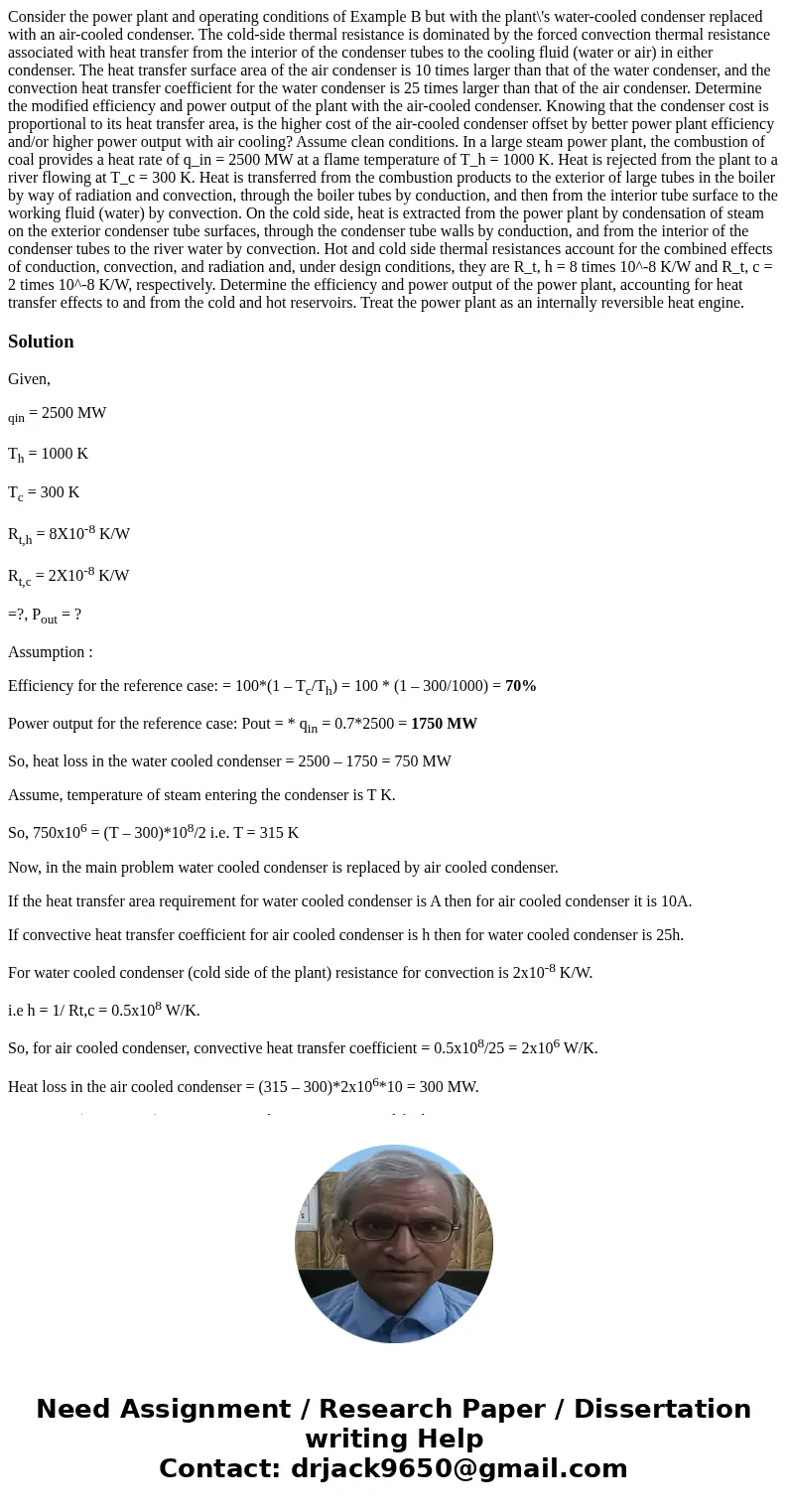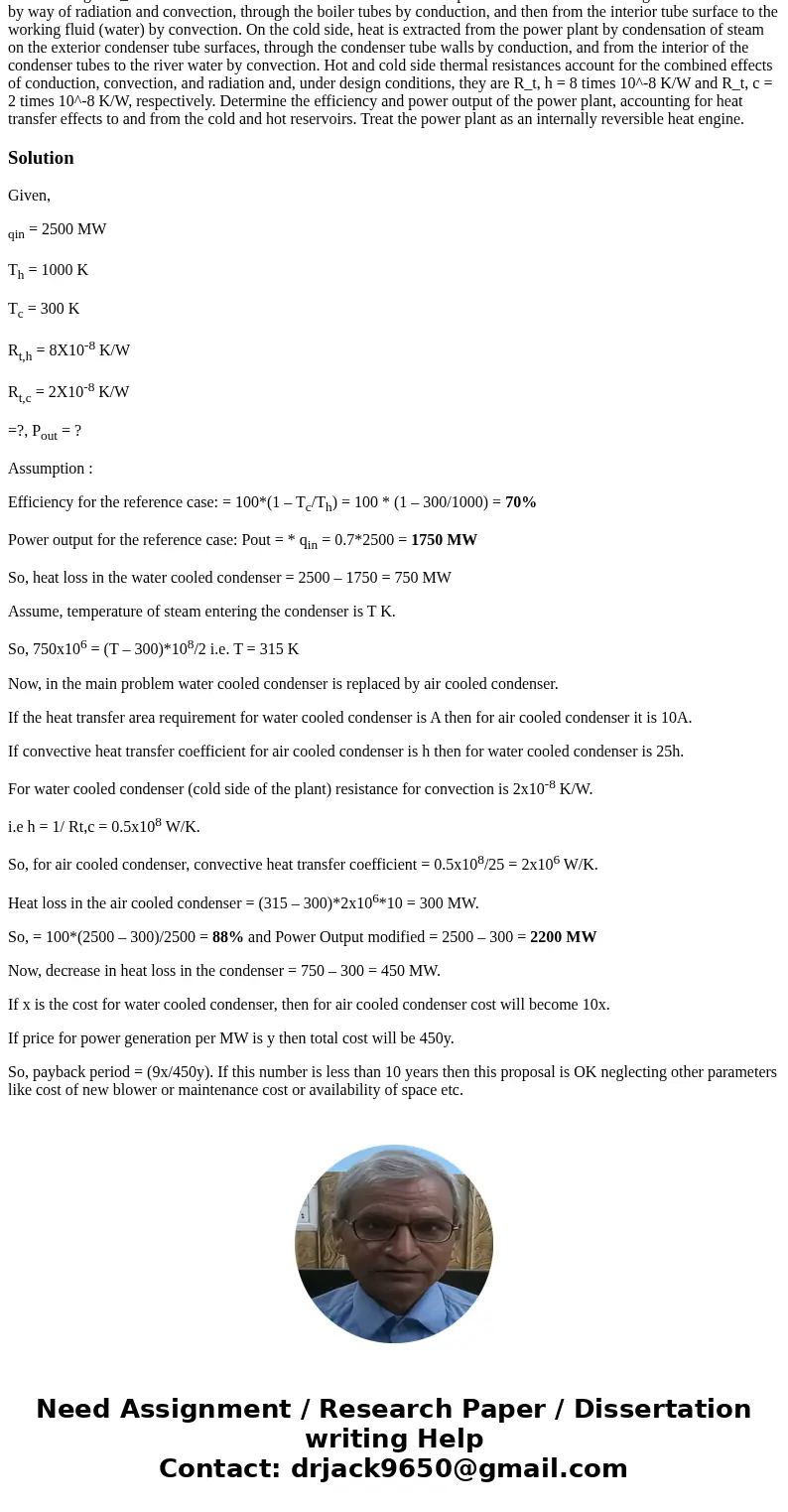Consider the power plant and operating conditions of Example B but with the plant\'s water-cooled condenser replaced with an air-cooled condenser. The cold-side thermal resistance is dominated by the forced convection thermal resistance associated with heat transfer from the interior of the condenser tubes to the cooling fluid (water or air) in either condenser. The heat transfer surface area of the air condenser is 10 times larger than that of the water condenser, and the convection heat transfer coefficient for the water condenser is 25 times larger than that of the air condenser. Determine the modified efficiency and power output of the plant with the air-cooled condenser. Knowing that the condenser cost is proportional to its heat transfer area, is the higher cost of the air-cooled condenser offset by better power plant efficiency and/or higher power output with air cooling? Assume clean conditions. In a large steam power plant, the combustion of coal provides a heat rate of q_in = 2500 MW at a flame temperature of T_h = 1000 K. Heat is rejected from the plant to a river flowing at T_c = 300 K. Heat is transferred from the combustion products to the exterior of large tubes in the boiler by way of radiation and convection, through the boiler tubes by conduction, and then from the interior tube surface to the working fluid (water) by convection. On the cold side, heat is extracted from the power plant by condensation of steam on the exterior condenser tube surfaces, through the condenser tube walls by conduction, and from the interior of the condenser tubes to the river water by convection. Hot and cold side thermal resistances account for the combined effects of conduction, convection, and radiation and, under design conditions, they are R_t, h = 8 times 10^-8 K/W and R_t, c = 2 times 10^-8 K/W, respectively. Determine the efficiency and power output of the power plant, accounting for heat transfer effects to and from the cold and hot reservoirs. Treat the power plant as an internally reversible heat engine.
Given,
qin = 2500 MW
Th = 1000 K
Tc = 300 K
Rt,h = 8X10-8 K/W
Rt,c = 2X10-8 K/W
=?, Pout = ?
Assumption :
Efficiency for the reference case: = 100*(1 – Tc/Th) = 100 * (1 – 300/1000) = 70%
Power output for the reference case: Pout = * qin = 0.7*2500 = 1750 MW
So, heat loss in the water cooled condenser = 2500 – 1750 = 750 MW
Assume, temperature of steam entering the condenser is T K.
So, 750x106 = (T – 300)*108/2 i.e. T = 315 K
Now, in the main problem water cooled condenser is replaced by air cooled condenser.
If the heat transfer area requirement for water cooled condenser is A then for air cooled condenser it is 10A.
If convective heat transfer coefficient for air cooled condenser is h then for water cooled condenser is 25h.
For water cooled condenser (cold side of the plant) resistance for convection is 2x10-8 K/W.
i.e h = 1/ Rt,c = 0.5x108 W/K.
So, for air cooled condenser, convective heat transfer coefficient = 0.5x108/25 = 2x106 W/K.
Heat loss in the air cooled condenser = (315 – 300)*2x106*10 = 300 MW.
So, = 100*(2500 – 300)/2500 = 88% and Power Output modified = 2500 – 300 = 2200 MW
Now, decrease in heat loss in the condenser = 750 – 300 = 450 MW.
If x is the cost for water cooled condenser, then for air cooled condenser cost will become 10x.
If price for power generation per MW is y then total cost will be 450y.
So, payback period = (9x/450y). If this number is less than 10 years then this proposal is OK neglecting other parameters like cost of new blower or maintenance cost or availability of space etc.


 Homework Sourse
Homework Sourse